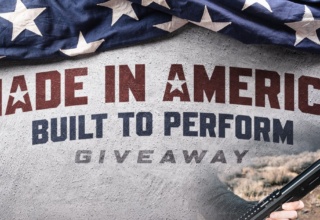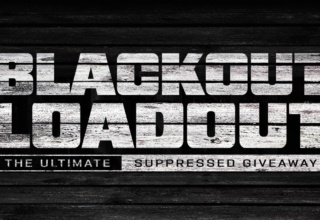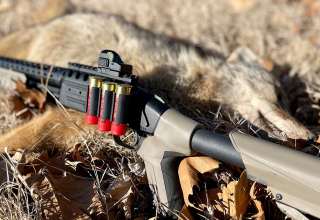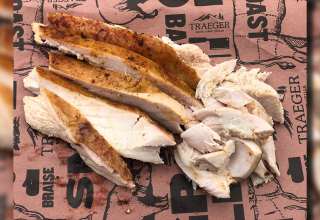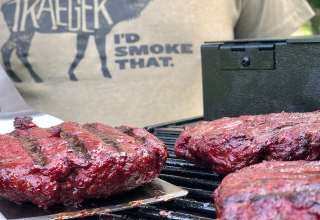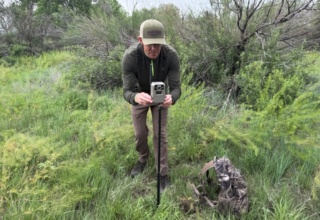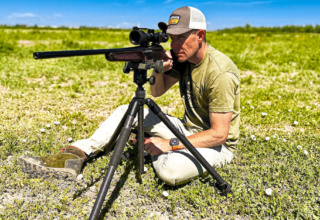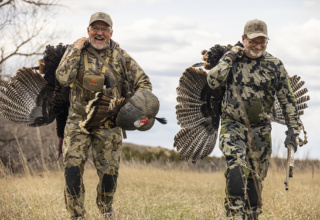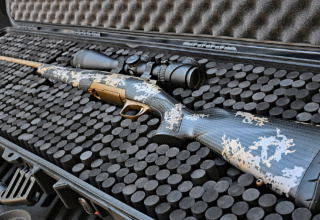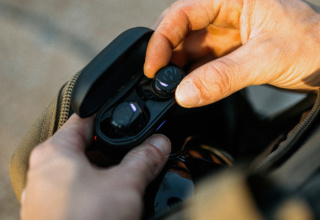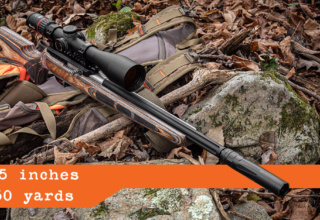When I was a teenager, a good friend of mine and I ventured out on a late summer evening to try our hand at calling predators. This being the first time we had ever went on our own, we went into it not really knowing what we were doing. We improvised and did what any young, inexperienced hunter would do and tried to imitate hunters on tv. Once we arrived on a local farmers land, we tried finding a spot in which we could see for a long distance. We settled on a brushy fence row that connected to the farmers hay barn and once we had set up in the fence row, I began playing a coyote pup in distress sound on an cassette style electronic caller. After the call had been playing for 5 to 6 minutes, I caught the attention of a herd of cattle that was feeding approximately 200 yards to our left.
All the cows had suddenly become alert, with a few of them even running in the opposite direction. I whispered to my friend to be ready because something was going on. A few seconds later a coyote appeared out of the timber, running towards our caller. Once the coyote got within 50 yards, my friend was able to make a successful shot, which dropped him immediately. The group of cattle had obviously given up the presence of the coyote, which in turn made us focus on the exact spot where he came from. In doing so, this allowed for us to get on the target quickly, and to make a successful harvest.
 That hunt not only hooked us on the sport of predator hunting, it also taught us to pay attention to the body language of livestock when hunting these intelligent animals. Acting as an alert to incoming coyotes is not the only benefit of hunting near farming areas. Over the past several years the majority of the predator hunting that I have done has been around farming areas, this is mostly in part to gaining access to land by farmers. One of the biggest threats to a farmer’s stock whether it be cattle, sheep, goats, or poultry is the coyote and this is a big factor as to why many landowners actually encourage hunters to harvest predators from their land.
That hunt not only hooked us on the sport of predator hunting, it also taught us to pay attention to the body language of livestock when hunting these intelligent animals. Acting as an alert to incoming coyotes is not the only benefit of hunting near farming areas. Over the past several years the majority of the predator hunting that I have done has been around farming areas, this is mostly in part to gaining access to land by farmers. One of the biggest threats to a farmer’s stock whether it be cattle, sheep, goats, or poultry is the coyote and this is a big factor as to why many landowners actually encourage hunters to harvest predators from their land.
Throughout the year, I have several farmers contact me when their calving is scheduled to start. Coyotes are notorious for being seen hanging out near cattle when this process is taking place, but not for the reason many may think. They don’t necessarily hang around to try to catch a baby calf, rather they tend to feed on the afterbirth. An occasional calf will get taken down, however, it is not as common as people think. The afterbirth is very nutritious to coyotes and this is what keeps them nearby. Farmers tend to start having a problem with coyotes once their population increases. An overpopulation of this predator can become dangerous to the cattle themselves, due to the higher demand of food to keep the coyotes thriving. It is the job hunters to manage this natural circle of life.
Another great benefit with hunting near livestock, is the attraction factor that a carcass can have. It is an unfortunate truth that cattle and calves can have complications causing the farmer to lose a valuable piece of their income, when this happens farmers will have to dispose of the carcass and it is usually somewhere on their land. Although this is a loss for the farmer, it can make excellent bait. Coyotes will not only feed on it for a few days, it actually becomes something that will keep them close to a specific area instead of their usual large travel route to find food. When coyotes are staying in a close area, it is a great time to add calling to the hunt as well, they will not be as hungry, however hunters can implement food source calls combined with a variety of coyote vocal sounds to successfully call them in.
 On a late October morning, I received a call from a good friend of mine who was seeing coyotes near a spot in which they had recently experienced the loss of a calf. He asked if I would hunt this specific spot for him and I readily agreed. As daylight began to ascend, I noticed that several cows had ventured into the pasture already, I proceeded to start a calling sequence on an electronic caller. Approximately 8 minutes into the sequence, I began to hear bawling from the cows at a distance to my left. Because of a heavy fog that morning, I was only able to see around 75 yards however, due to the cattle being alarmed by something out of my line of sight, I had my eyes locked in their direction. A few moments later, a coyote appeared out of the fog, he was only a few yards behind my caller/decoy when I first caught his movement. I quickly took my Rock River Arms LAR-8 Predator HP in a .308 caliber, got on the coyote and squeezed the trigger. Unfortunately, I missed the first shot but was able to connect on my second attempt because of the AR’s ability to get a second shot off quick.
On a late October morning, I received a call from a good friend of mine who was seeing coyotes near a spot in which they had recently experienced the loss of a calf. He asked if I would hunt this specific spot for him and I readily agreed. As daylight began to ascend, I noticed that several cows had ventured into the pasture already, I proceeded to start a calling sequence on an electronic caller. Approximately 8 minutes into the sequence, I began to hear bawling from the cows at a distance to my left. Because of a heavy fog that morning, I was only able to see around 75 yards however, due to the cattle being alarmed by something out of my line of sight, I had my eyes locked in their direction. A few moments later, a coyote appeared out of the fog, he was only a few yards behind my caller/decoy when I first caught his movement. I quickly took my Rock River Arms LAR-8 Predator HP in a .308 caliber, got on the coyote and squeezed the trigger. Unfortunately, I missed the first shot but was able to connect on my second attempt because of the AR’s ability to get a second shot off quick.
On this specific hunt, my beliefs in beneficial farm hunting were confirmed. The carcass of the lost calf lured the coyotes in to a specific spot and as with my first predator hunt several years ago, the cows made enough noise to give up the location of the approaching coyote. This confirmed that predator hunting when cows are present makes for ideal calling conditions. My advice is to start knocking on the doors of local farmers to obtain permission to hunt their land and these elusive animals.


